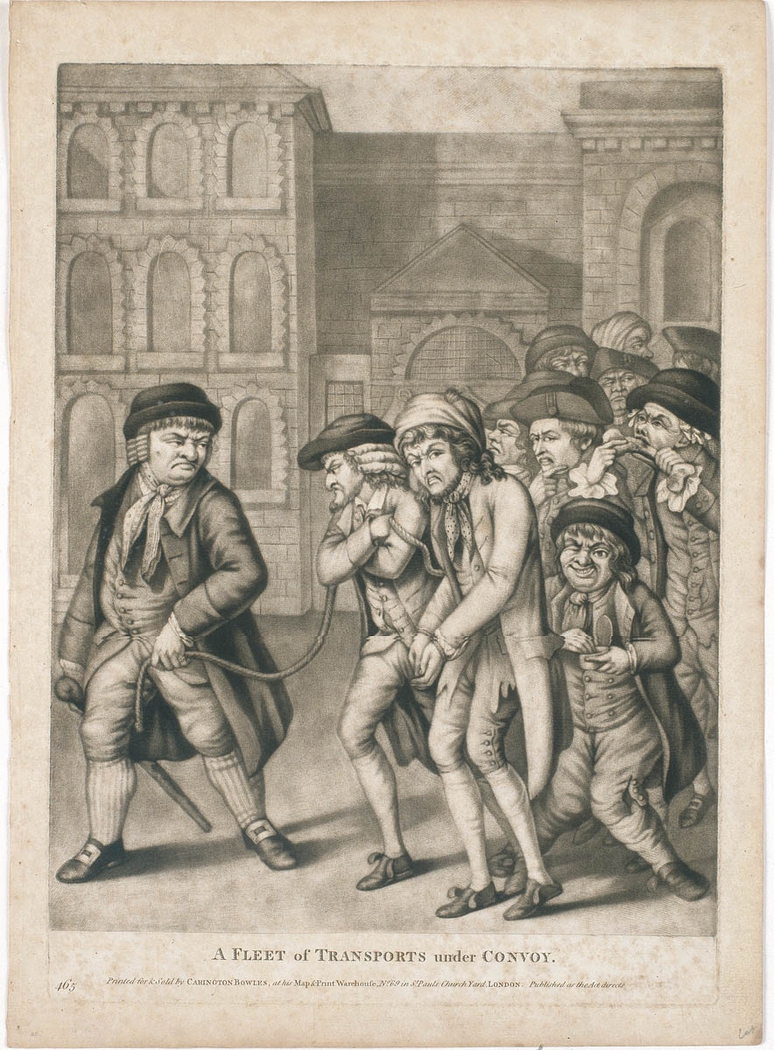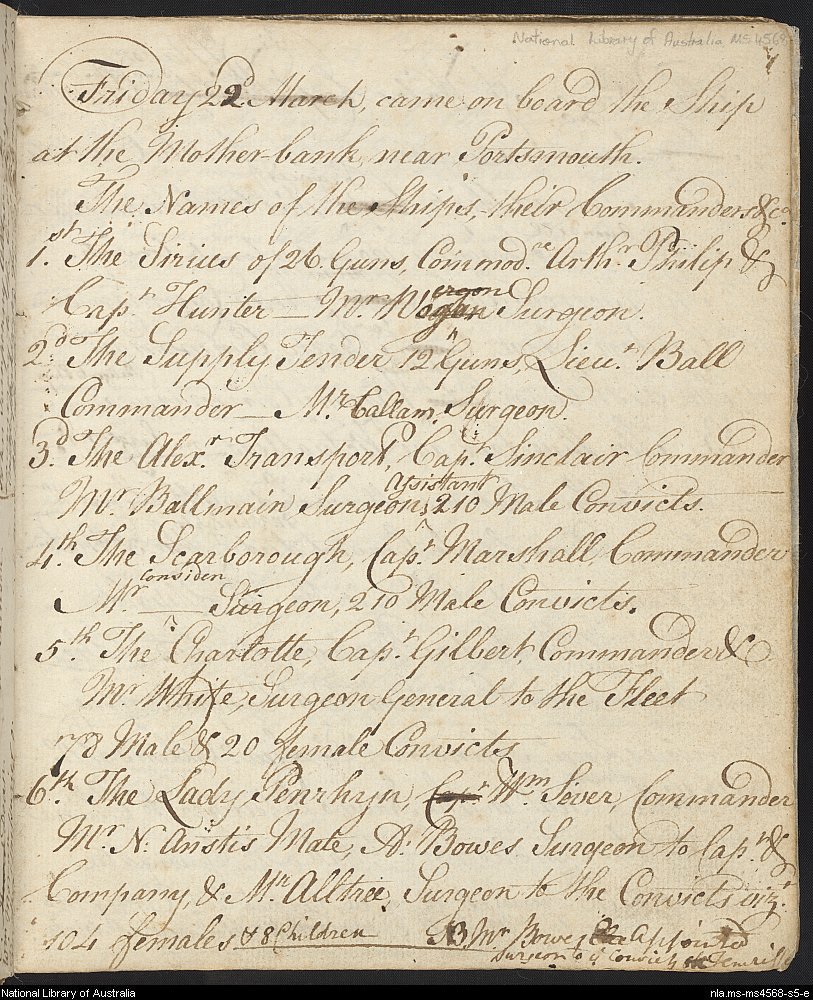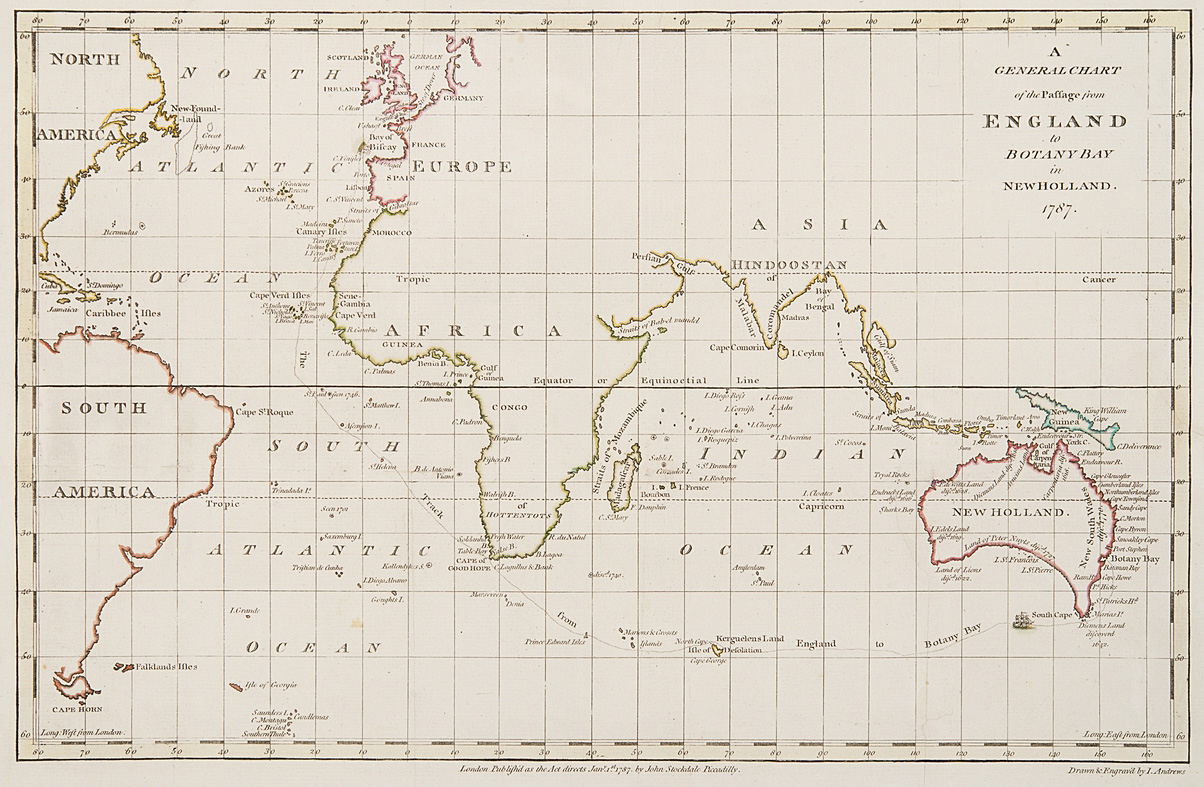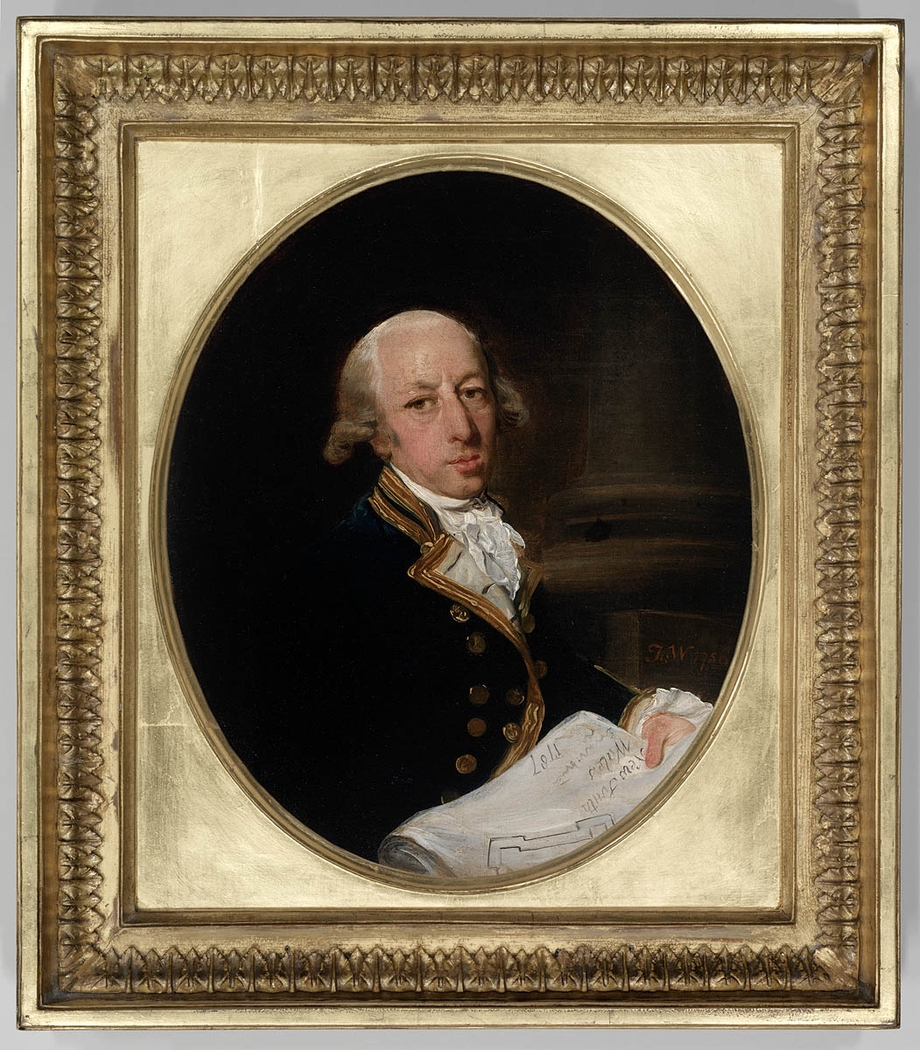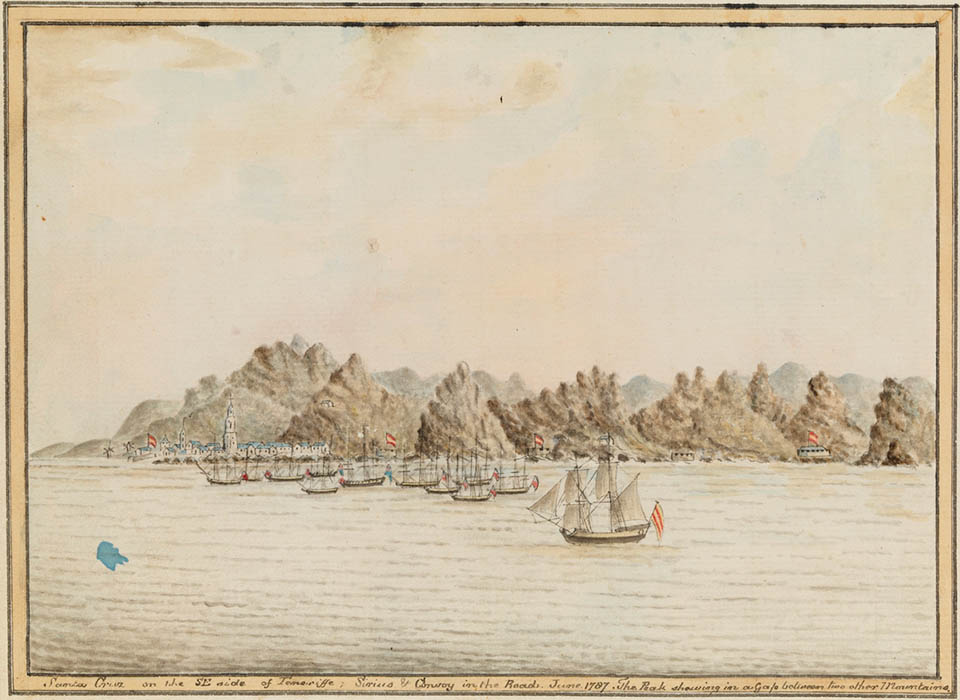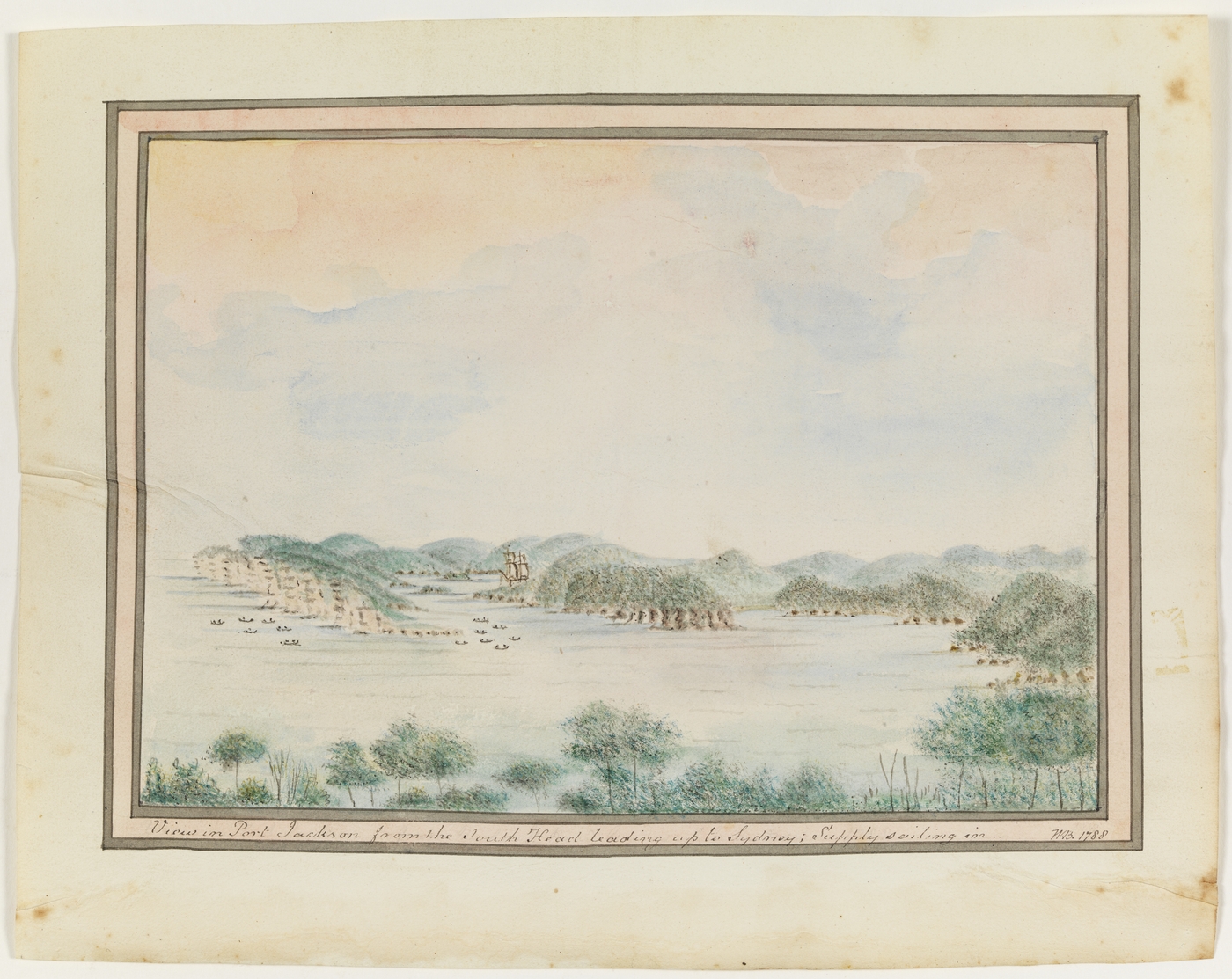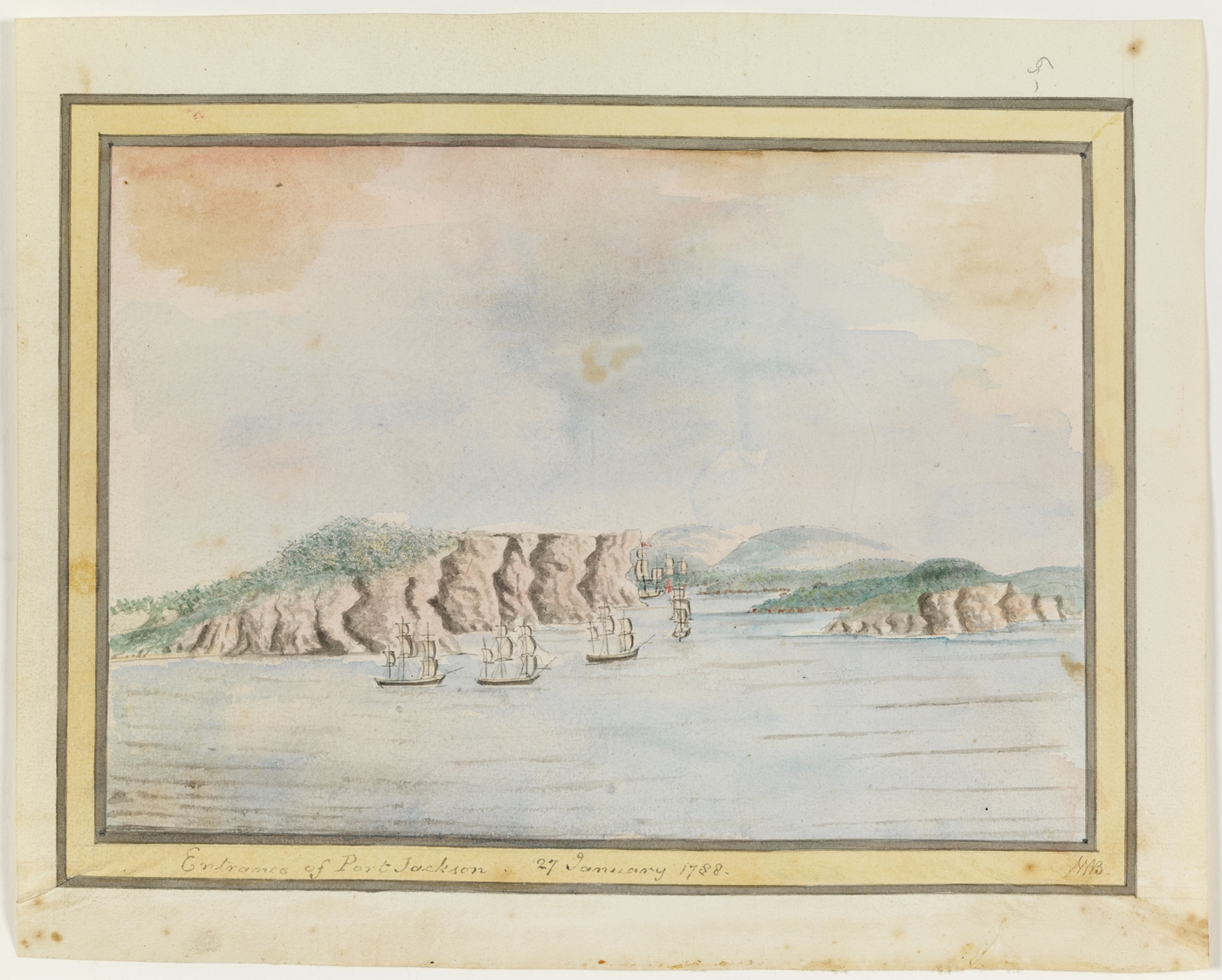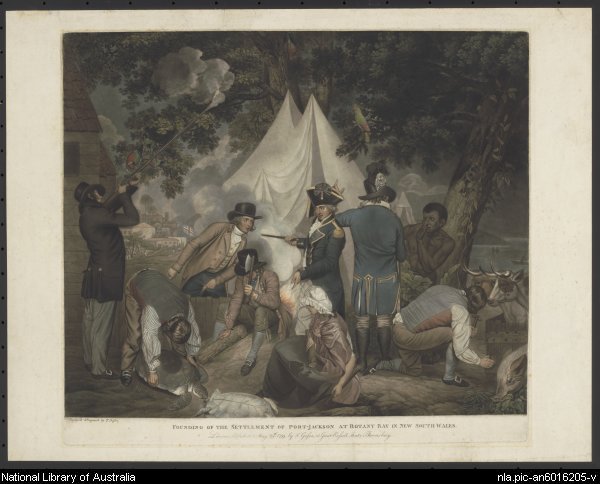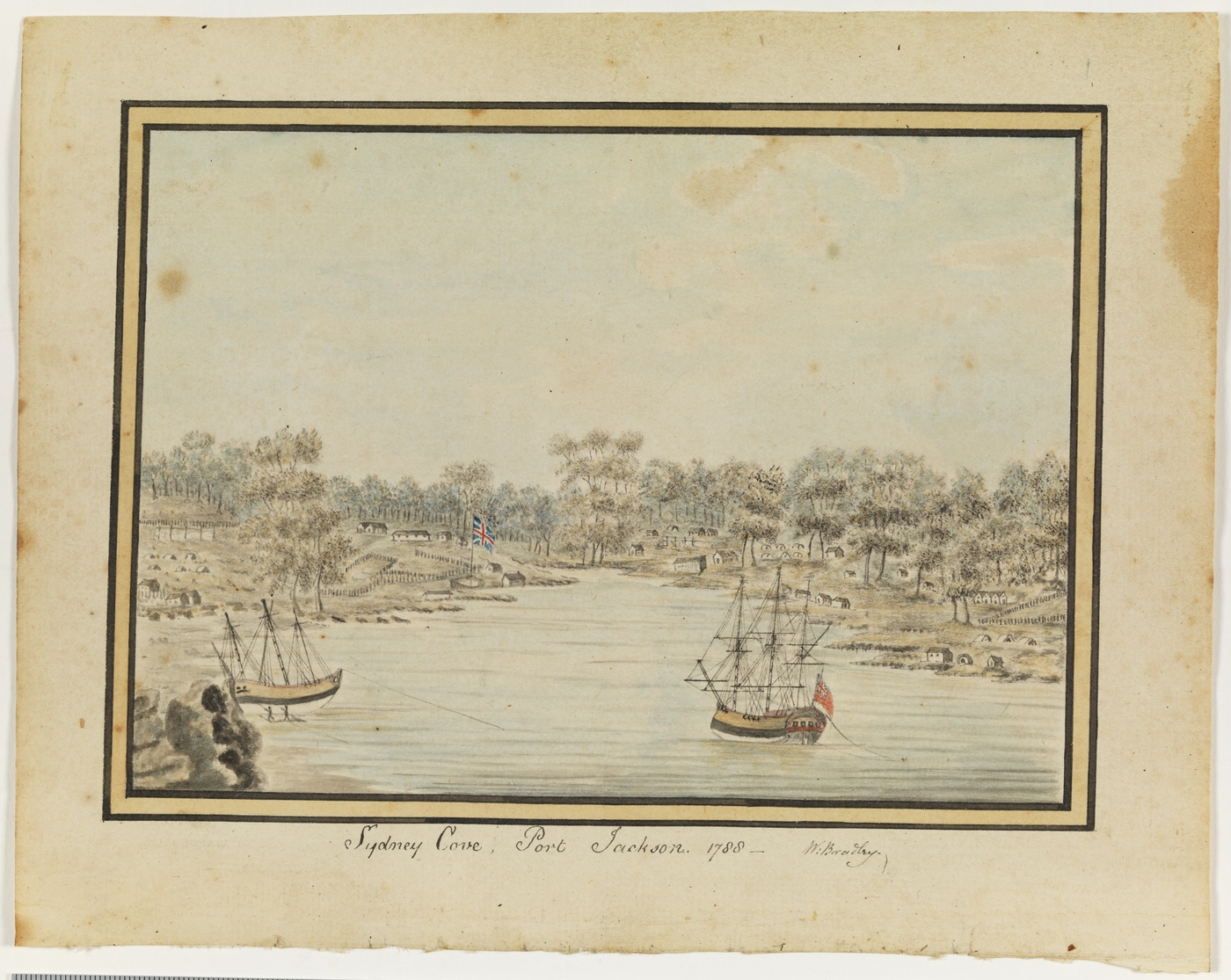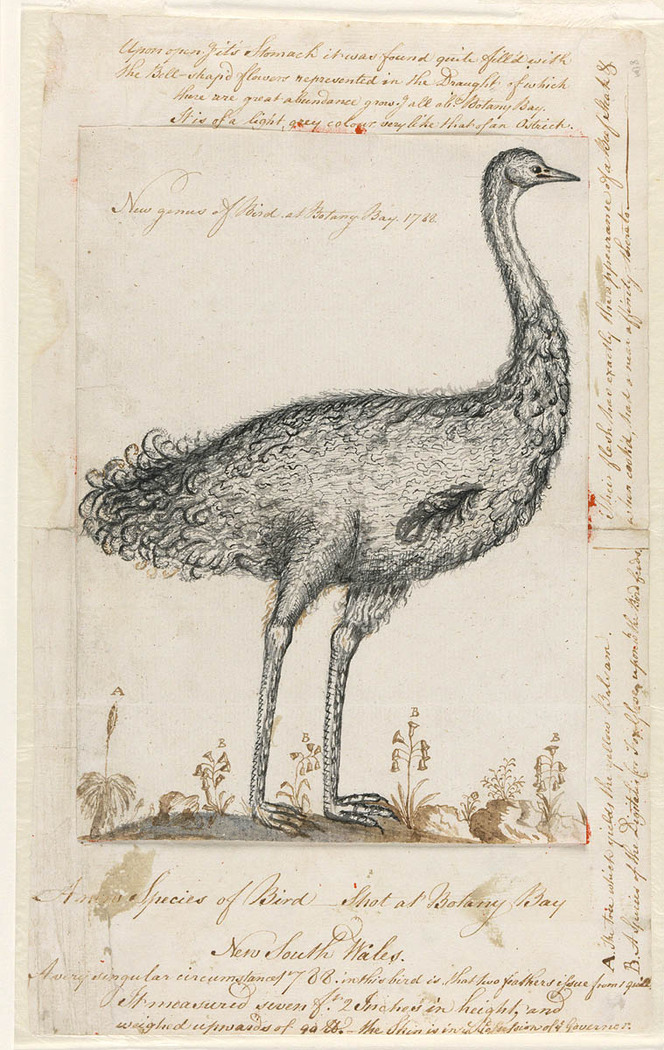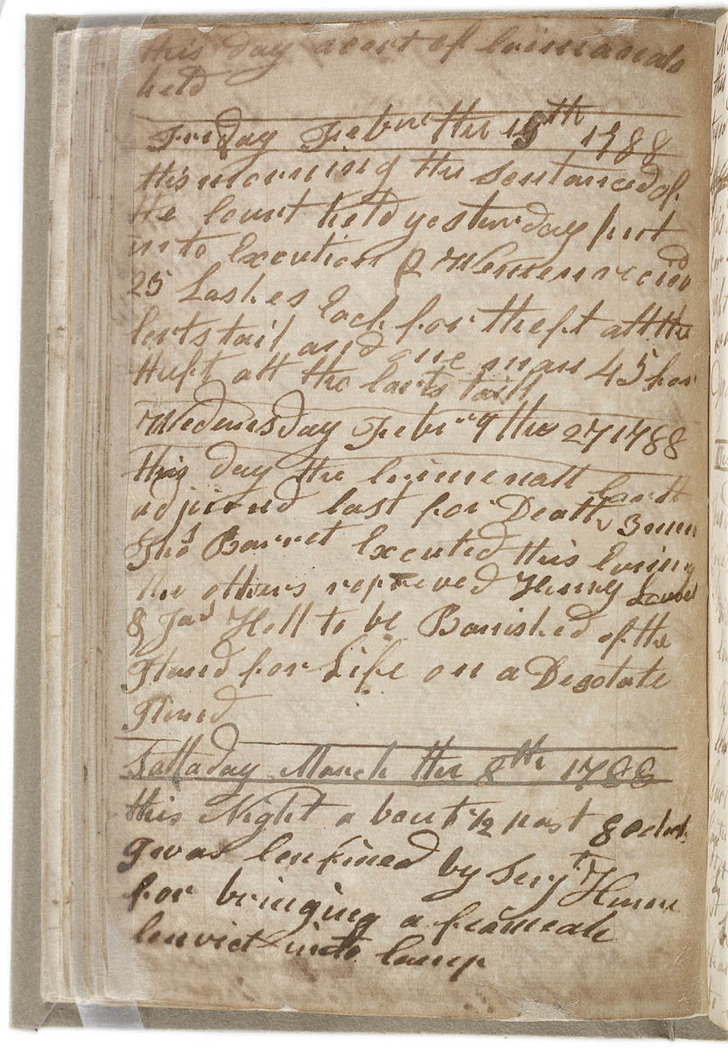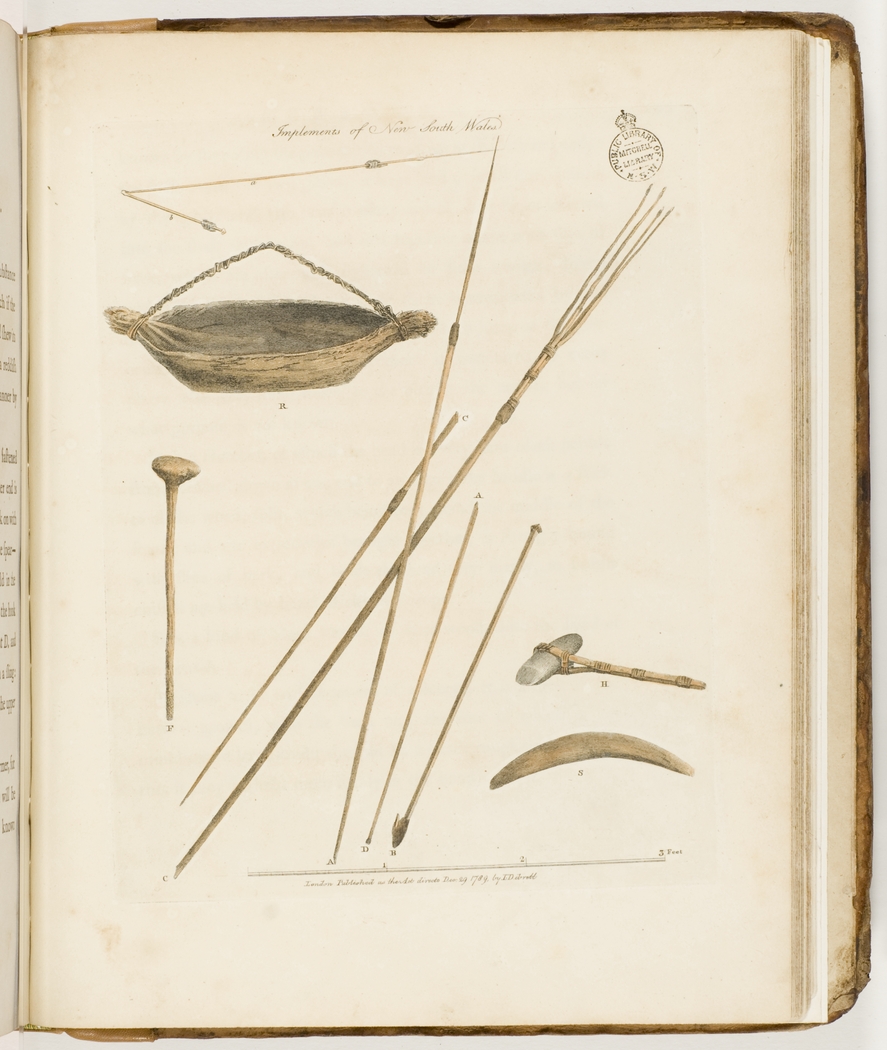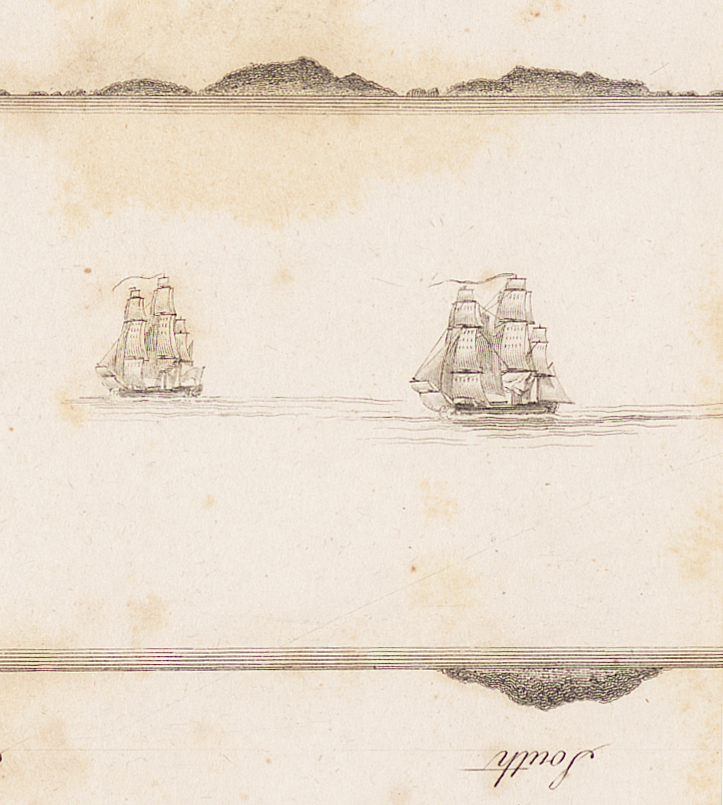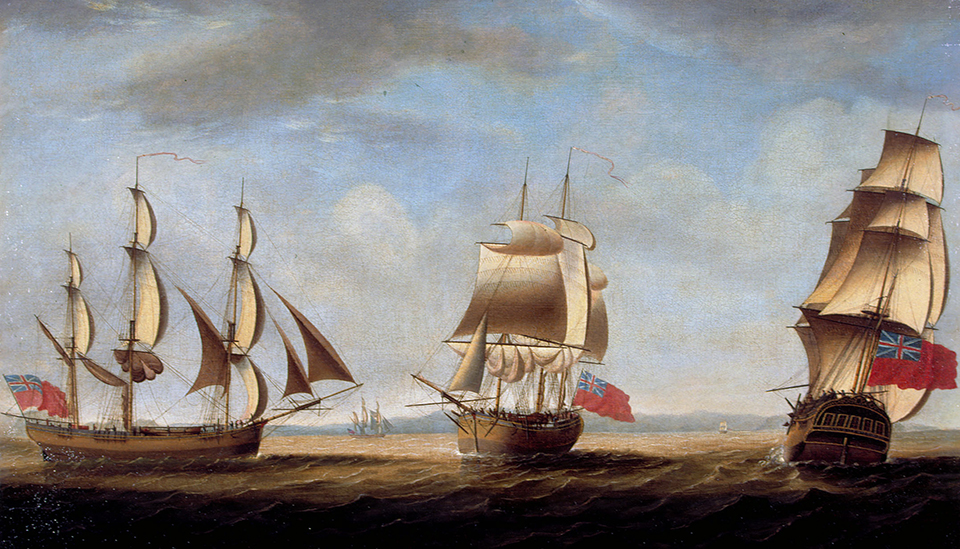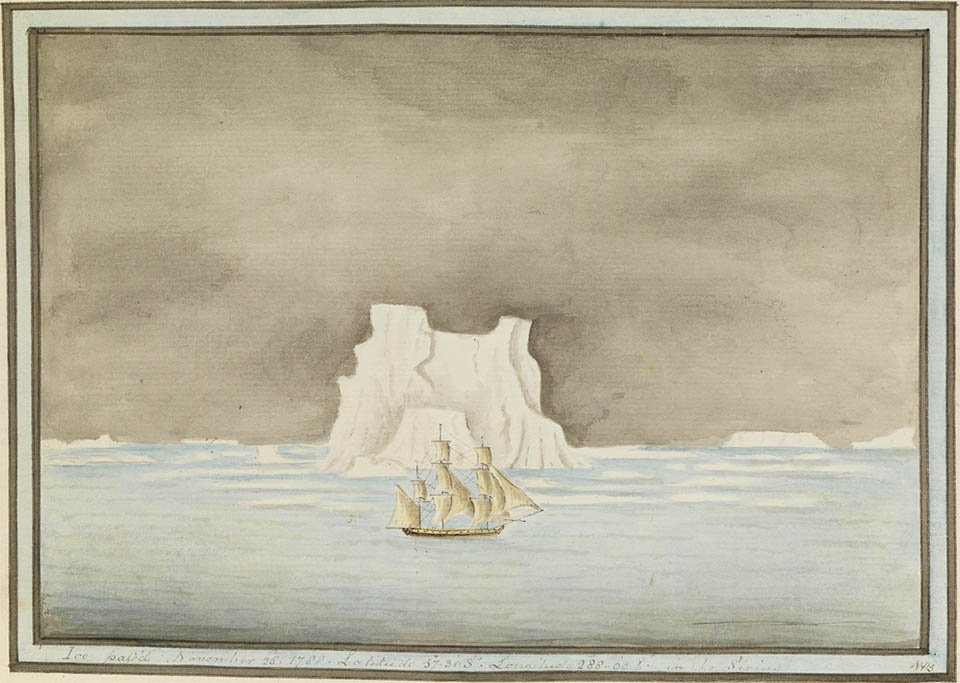The Dictionary of Sydney was archived in 2021.
First Fleet
Citation
Persistent URL for this entry
To cite this entry in text
To cite this entry in a Wikipedia footnote citation
To cite this entry as a Wikipedia External link
The First Fleet
[media]With the end of the American War of Independence, it became clear that Britain could no longer send its convicts to North America, and the search began for an alternative destination. For a time Africa was considered a possibility but by early 1786 it was evident that there were no convenient sites on that continent that would not result in high mortality among the convicts. In August of that year, William Pitt and his ministers settled on Botany Bay, on the south east coast of New Holland, which had been discovered by Captain James Cook 16 years before.
[media]The First Fleet was commissioned in the spring of 1786 and sailed from England on the morning of the 13 May 1787. [media]The fleet consisted of nine merchant ships – six of them carrying convicts and marines (Alexander, Charlotte, Friendship, Lady Penrhyn, Prince of Wales and Scarborough) and three loaded with stores and equipment (Borrowdale, Fishburn and Golden Grove) – and two naval vessels, the Sirius and the Supply.
[media]There were few places on earth further away from England than New South Wales and historians have long debated whether the new settlement was merely a dumping ground for convicts or part of some larger imperial plan. There is no direct evidence that it was anything other than a response to overcrowded gaols, but Alan Frost has argued that the decision must be viewed against a background of British expansion into the Indian and Pacific Oceans. [1]
Managing the fleet
[media]Conducting a convoy of 11 ships, nine of them merchant vessels, on a voyage to the far side of the globe was challenging and Captain Arthur Phillip, the commodore of the fleet, managed the ships closely to ensure that they remained in company. [2] Using different combinations of flags and masts, lights and shots, the commodore could warn the fleet of danger, make them sail closer together or send them into port. If the message was more complicated, Phillip would signal for the masters to come on board the Sirius to be briefed or send one of his officers around the fleet with written instructions.
The Supply was used as a utility vessel, sailing ahead as a lookout for land, remaining in-shore with a light showing when the ships were near land, and moving around the fleet to issue instructions on how the ships were to enter harbour. Phillip [media]kept the fleet in tight order, and when Collins wrote that '[the] convoy behaved well, paying more attention and obedience to signals than ships in the merchant service are commonly known to do', he was giving credit to the commodore's close management of the ships as much as the compliance of the masters. [3]
Much more difficult was the task of managing 775 convicts scattered across six overcrowded transports. Phillip was generous in his treatment of the prisoners, removing their irons and allowing them the freedom of the upper deck throughout the day (and some at night), and ensuring that the convict quarters were regularly scrubbed and fumigated. [media]They touched at three foreign ports – Tenerife, Rio de Janeiro and the Cape of Good Hope – so they could be supplied with fresh meat and vegetables. The result was a mortality rate of a little more than three per cent for the voyage, somewhat less than would have been the case had they remained in British gaols.
The punishments handed out to convicts and crew members throughout the voyage were generally mild. The most severe flogging given to any convict was the 37 lashes administered to John Bennett on the Friendship, two weeks after sailing, for breaking out of irons. It was not until Rio de Janeiro that the first corporal punishment was administered on board the Charlotte, and the first flogging did not occur on the Prince of Wales until some weeks after that.
The end of the voyage
[media]Of the voyage south through the Atlantic, one of the officers wrote that it was 'too beaten to afford us anything new or interesting'. [4] And while the passage from the Cape had rarely been traversed, the fleet could rely on Cook's Voyages, sailing eastward at around 43 degrees south latitude until they reached Van Diemen's Land, then following the coast of New South Wales north until they arrived at Botany Bay.
The ships sailed [media]into Botany Bay over a three-day period, from 18 to 20 January 1788. Upon inspection, Phillip realised that the sandy soil and limited water supply were inadequate for a settlement of almost 1,400 souls, and on 25 and 26 January, the convoy was relocated to Port Jackson, several leagues to the north.
[media]Sydney Cove was selected because of a stream (later known as the Tank Stream) which ran down the southern end of the inlet, the depth of the water close to the shore, and
...many rock eminences, quite perpendicular & perfectly flat at top wh. will answer every purpose of loadg and unloadg the Largest Ships equally the same as if made by the most expert workmen… [5]
[media]Accompanied by an advance party of marines, convicts and seamen, Phillip went ashore on the morning of 26 January, to begin clearing a campsite at the head of the cove, on the western side of the stream. There has been debate as to where the landing took place. For some years it was thought to have occurred at the southern end of the cove, in what is now Loftus Street, but documents have come to light in recent years which make it clear that it occurred on the western side, among rocks that have since been buried behind the Overseas Passenger Terminal. [6]
Ships in port
[media]While they remained in port, the merchant ships were a corrupting influence: they offered the convicts a ready supply of liquor and they held out the tantalising prospect of escape. Over the nine months that merchant ships were anchored in the cove, Phillip issued a succession of port orders designed to keep camp and fleet apart – with limited success. [7]
[media]From as early as 27 January, the sailors were forbidden to be on shore after sunset. [8] Over time, exceptions were made, but this prohibition was often breached: John Fisher, a young seaman on the Lady Penrhyn, swam ashore every night to spend time in the bush with his convict lover, Catherine Hart. [9]
On 3 February, the masters of the transports were given permission to fire on any convicts who attempted to swim to and board their ships, and the seamen were forbidden to go into the convict camps without permission from the officer of the guard. [10]
[media]Two days after the female convicts were landed on 6 February, a sailor was caught in the women's tents and driven out of camp to fife and drum, with his hands tied behind his back. Three days later, a ship's carpenter, a seaman and one of the boys were discovered in the women's camp. The boy was dressed in petticoats, the men's hands were tied and they were drummed out of camp to the tune of the 'Rogue's March', a ritual usually reserved for disgraced soldiers. Four days after that, half a dozen sailors from different ships were removed from a makeshift guardhouse and paraded back to their ships in the same way. [11]
[media]The sailors were expressly forbidden to give liquor to the convicts, and written permission was required from the Governor to bring any spirits on shore. These directives did not have much effect either. The first court case in the new settlement, held on 11 February, involved a drunken convict who had been supplied with rum by sailors, allegedly in return for helping them make their way safely to the women's camp. [12]
David Collins wrote that:
…the sailors from the transports, although repeatedly forbidden, still persisted in bringing spirits on shore by night, and drunkenness was often the consequence. [13]
[media]On 13 February, an order was issued prohibiting the ships' boats from touching anywhere in the cove after sunset except at the public landing place on the western side, so that the guard could supervise their movements. [14]
The convicts had a variety of services they could offer in return for alcohol and tobacco: some of the women provided laundry and mending services, and the men supplied exotic flora and fauna, and Aboriginal artefacts. From their earliest encounters with the natives, the officers and gentlemen had been exchanging mirrors and clothing for clubs, spears and shields; their avidity was not overlooked by the convicts.
[media]The Aboriginal people were in the habit of leaving their possessions lying around under rocks and on the beaches, and a number of these articles were stolen and sold to the ships' officers. [15] Among other things, this threatened the security of the settlement, and Phillip attempted to destroy the trade by declaring that anyone who bought spears, fizgigs, gum or other such articles from convicts would be prosecuted as a purchaser of stolen goods. [16] This directive also had little impact. [17] Native animals were added to the list of forbidden trade in mid-February around the time that the steward of the Scarborough was caught buying a possum from one of the convicts. [18]
Sailing for home
[media]The Charlotte, the Lady Penrhyn and the Scarborough were the first of the ships to be cleared, sailing for Canton in early May to carry home a cargo of tea on behalf of the East India Company. They made their way through the islands of Micronesia, discovering the Gilbert and Marshall Islands (the former now known as Kiribati), which are both named after First Fleet captains.
[media]The Alexander, the Friendship, the Prince of Wales and the Borrowdale were dispatched in July after undergoing necessary repairs. The Alexander and the Friendship returned through the East Indies, although the Friendship was deliberately sunk in the Macassar Strait after the crews of both ships were struck with scurvy, and they were no longer able to sail both. The Prince of Wales and the Borrowdale sailed around Cape Horn, the first ships to do so since Furneaux and Cook had pioneered that route more than a decade before. The other two were kept back until November, the Fishburn as a secure store for the liquor, the Golden Grove carrying people and provisions to a secondary settlement established on Norfolk Island. They also returned around Cape Horn. [19]
[media]At home, the progress of the fleet had been followed with great interest, as letters from officers, marines and convicts written at Tenerife, Rio de Janeiro and the Cape arrived back in England and were published and republished in the English press. [20] The earliest reports from the colony were published in late February 1789, brought from the Cape of Good Hope by a Dutch East Indiaman. [21]
The Prince of Wales was the first of the ships to return, sailing into Falmouth on 22 March 1789 and confirming that the expedition had arrived safely at Botany Bay. [22] The last of the First Fleet transports, the Lady Penrhyn, was at Deptford unloading her tea and the passengers' baggage by 15 August. [23]
[media]The two naval vessels, Sirius and Supply, remained in the colony. In October 1788, the Sirius was sent to the Cape for provisions, a perilous round-the-world voyage through icebergs. She sank off Norfolk Island in March 1790, as she was preparing to sail for China for more provisions. The Supply was employed in ferrying people and stores between Sydney Cove and Norfolk Island. Following the loss of the Sirius, she was sent to Batavia, where a Dutch ship was hired to bring back much-needed provisions. She returned home in late 1791.
References
Bradley, William. A Voyage to New South Wales, 1786–1792. Sydney: Public Library of New South Wales, 1969.
Collins, David. An Account of the English Colony in New South Wales; With Remarks on the Dispositions, Customs, Manners &c. of the Native Inhabitants of that Country. Vol 1, 1798. Edited by H Fletcher. Sydney: AH & AW Reed in association with the Royal Australian Historical Society, 1975.
Fidlon, Paul G and RJ Ryan. Eds. The Journal of Arthur Bowes Smyth. Sydney: Australian Documents Library, 1979.
Gillen, Mollie. The Founders of Australia. Sydney: Library of Australian History, 1989.
Scott, James. Remarks on a Passage to Botany Bay, 1787–1792. Sydney: Angus and Robertson, 1963.
Tench, Watkin. Sydney's First Four Years. Sydney: Library of Australian History, 1979.
Tench, Watkin. Sydney's First Four Years; being a reprint of A narrative of the expedition to Botany Bay and A complete account of the settlement at Port Jackson. Introduction and annotations by LF Fitzhardinge. Sydney: Library of Australian History, 1979.
Notes
[1] Alan Frost, The Global Reach of Empire (Melbourne: Miegunyah Press, 2003)
[2] Gary Sturgess, 'Commodore of the Fleet' (paper presented at The First Governor – a Bicentenary Symposium on Arthur Phillip, Museum of Sydney, 5 Sept 2014).
[3] See for example, David Collins, An Account of the English Colony in New South Wales (Sydney: AH and AW Reed, 1975), 1: lxxxvii and lxxxix
[4] David Collins, An Account of the English Colony in New South Wales; With Remarks on the Dispositions, Customs, Manners &c. of the Native Inhabitants of that Country, vol 1, 1798, ed H Fletcher (Sydney: AH & AW Reed in association with the Royal Australian Historical Society, 1975), lxvi
[5] Phillip to Sydney, 15 May 1788, Historical Records of New South Wales, 1: 2, 122; Arthur Bowes Smyth, 'Journal of Arthur Bowes Smyth, 22 March 1787 to 8 August 1789', National Library of Australia, MS4568, 23 January 1788. A published version of this journal is somewhat different; see Paul G Fidlon and RJ Ryan, eds, The Journal of Arthur Bowes Smyth (Sydney: Australian Documents Library, 1979), 62
[6] Michael Flynn and Gary Sturgess, 'New Evidence on Arthur Phillip's First Landing Place – 26 January 1788', History: Magazine of the Royal Australian Historical Society, (December 2014) no 122, 3–5
[7] These directives were issued on various dates over the first few months of settlement and brought together in a single set of port orders on 16 October 1788. This was republished Sydney Gazette and New South Wales Advertiser, 10 October 1827, 2
[8] Paul G Fidlon and RJ Ryan, eds, The Journal of Arthur Bowes Smyth, (Sydney: Australian Documents Library, 1979), 64. The original version of his journal is even more explicit, stating that sailors caught on shore at night were at risk of being shot by the picket. See Arthur Bowes Smyth, 'Journal of Arthur Bowes Smyth, 22 March 1787 to 8 August 1789', 27 January 1788, National Library of Australia MS4568
[9] Paul G Fidlon and RJ Ryan, eds, The Journal of Arthur Bowes Smyth (Sydney: Australian Documents Library, 1979), 77–78; Mollie Gillen, The Founders of Australia (Sydney: Library of Australian History, 1989), 164
[10] 'Captn Campbell's Orderly Book', 5, in James Scott, Remarks on a Passage to Botany Bay, 1787–1792 (Sydney: Angus and Robertson, 1963)
[11] Log of the Alexander, UK National Archives ADM51/4375, 5 February 1788; Paul G Fidlon and RJ Ryan, eds, The Journal of Arthur Bowes Smyth (Sydney: Australian Documents Library, 1979), 70; Arthur Bowes Smyth, 'A Journal of a Voyage from Portsmouth to New South Wales and China in the Lady Penrhyn...1787–1778–1789', State Library of New South Wales, safe 1/15, 147–149; Arthur Bowes Smyth, 'Journal of Arthur Bowes Smyth, 22 March 1787 to 8 August 1789', National Library of Australia MS4568, 9 and 13 February 1788; Paul G Fidlon and RJ Ryan, eds, The Journals and Letters of Lt. Ralph Clark, 1787–1792 (Sydney: Australian Documents Library, 1981), 97,and 98
[12] R v Barsby, NSW Court of Criminal Jurisdiction, 11 February 1788, in NSW State Records,5/1147A; Bruce Kercher and Brent Salter, eds, The Kercher Reports (Sydney: The Francis Forbes Society for Australian Legal History, 2009), 1–7
[13] David Collins, An Account of the English Colony in New South Wales; With Remarks on the Dispositions, Customs, Manners &c. of the Native Inhabitants of that Country, vol 1, 1798, ed H Fletcher (Sydney: AH & AW Reed in association with the Royal Australian Historical Society, 1975), 7
[14] On the prohibition on bringing liquor ashore and the breach of those orders see David Collins, An Account of the English Colony in New South Wales; With Remarks on the Dispositions, Customs, Manners &c. of the Native Inhabitants of that Country, vol 1, 1798, ed H Fletcher (Sydney: AH & AW Reed in association with the Royal Australian Historical Society, 1975), 7; Standing Port Orders, 16 October 1788, Sydney Gazette and New South Wales Advertiser, 10 October 1827, 2. The log of the Borrowdale for 13 February 1788 reports an order that 'no boats should land on the west side of the cove', See UK National Archives ADM51/4375. This is almost certain a mistake, since the consolidated port orders of 16 October 1788 include the following: 'No boats are ever to remain on shore after sunset in any part of this harbour, except at the public landing-place, on the west side of Sydney Cove', Sydney Gazette and New South Wales Advertiser, 10 October 1827, 2. Convicts continued to bring liquor ashore. See R v Clay, Magistrates Court: Minutes of Proceedings, 22 February 1788, NSW State Records COD 17
[15] Captain Watkin Tench and Arthur Bowes Smyth obtained clubs in return for looking glasses when they encountered Aboriginal people on 21 January in Botany Bay. See Watkin Tench, Sydney's First Four Years (Sydney: Library of Australian History, 1979), 36; Paul G Fidlon and RJ Ryan, eds, The Journal of Arthur Bowes Smyth (Sydney: Australian Documents Library, 1979), 57.Smyth obtained a hatchet on 28 February, but he does not acknowledge what he traded for it. See Paul G Fidlon and RJ Ryan, eds, The Journal of Arthur Bowes Smyth (Sydney: Australian Documents Library, 1979), 75. On 2 March, the Governor traded a straw hat for a spear, an exchange that left the other party somewhat dissatisfied. Three days later, Phillip traded some unnamed articles for spears, in another example where the other party seems to have been left unhappy with the deal. See William Bradley, A Voyage to New South Wales, 1786–1792 (Sydney: Public Library of New South Wales, 1969), 87–88, 93–94. In July 1788, a marine sergeant apologised to a friend that he could not obtain 'anything curious or uncommon' because they have been bought up by the officers and gentlemen. See Hampshire Chronicle, 25 May 1789, 4
[16] There are three descriptions of this particular order David Collins, An Account of the English Colony in New South Wales; With Remarks on the Dispositions, Customs, Manners &c. of the Native Inhabitants of that Country, vol 1, 1798, ed H Fletcher (Sydney: AH & AW Reed in association with the Royal Australian Historical Society, 1975), 13; Watkin Tench, Sydney's First Four Years (Sydney: Library of Australian History, 1979), 135; Standing Port Orders, 16 October 1788, Sydney Gazette and New South Wales Advertiser, 10 October 1827, 2. A passage in a letter by the chaplain, Richard Johnson, may indicate that there was a prohibition on trade with the local people prior to 25 January when the ships were still in Botany Bay, although the date is not entirely clear. See Johnson to Fricker, 10 February 1788, in George Mackaness, ed, 'Some Letters of Rev Richard Johnson', Australian Historical Monographs, XX and XXI (series news), (Sydney, 1954), no 2
[17] David Collins, An Account of the English Colony in New South Wales; With Remarks on the Dispositions, Customs, Manners &c. of the Native Inhabitants of that Country, vol 1, 1798, ed H Fletcher (Sydney: AH & AW Reed in association with the Royal Australian Historical Society, 1975), 13
[18] R v Stow, Magistrates Court, 22 February 1788 and R v Meredith, 23 and 25 February 1788, NSW State Records, COD 17; Paul G Fidlon and RJ Ryan, eds, The Journal of Arthur Bowes Smyth (Sydney: Australian Documents Library, 1979), 74; Paul G Fidlon and RJ Ryan, eds, The Journals and Letters of Lt. Ralph Clark, 1787–1792 (Sydney: Australian Documents Library, 1981), 101
[19] On the China ships, see Log of the Alexander, UK National Archives ADM51/4375, 4, 5 and 6 May 1788; Log of the Fishburn, UK National Archives ADM51/4375, 4 and 6 May 1788; Log of the Friendship, UK National Archives ADM51/4376, 5 and 6 May 1788; Log of the Golden Grove, UK National Archives ADM51/4376, 6 May 1788; Log of the Prince of Wales, UK National Archives ADM51/4376, 5 May 1788; Thomas Gilbert, Voyage from New South Wales to Canton in the Year 1788...(London: J Debrett, 1789), 1–2; David Collins, An Account of the English Colony in New South Wales; With Remarks on the Dispositions, Customs, Manners &c. of the Native Inhabitants of that Country, vol 1, 1798, ed H Fletcher (Sydney: AH & AW Reed in association with the Royal Australian Historical Society, 1975), 22; Watkin Tench, Sydney's First Four Years (Sydney: Library of Australian History, 1979), 59; John White, Journal of a Voyage to New South Wales (Sydney: Angus and Robertson, 1962), 132; Paul G Fidlon and RJ Ryan, eds, The Journal of Arthur Bowes Smyth (Sydney: Australian Documents Library, 1979), 80; William Bradley, A Voyage to New South Wales, 1786–1792 (Sydney: Public Library of New South Wales, 1969), 105; John Easty, Memorandum of the Transactions of a Voyage from England to Botany Bay, 1787–1793 (Sydney: Angus and Robertson, 1965), 101. On the Alexander, the Friendship, the Borrowdale and the Prince of Wales, see Log of the Alexander, UK National Archives ADM51/4375, 14 July 1788; Log of the Borrowdale, UK National Archives ADM51/4375, 14 May 1788; Log of the Fishburn, UK National Archives ADM51/4375, 13 and 14 July 1788; Log of the Friendship, UK National Archives ADM51/4376, 14 July 1788; Log of the Golden Grove, UK National Archives ADM51/4376, 13 July 1788; Log of the Prince of Wales, UK National Archives ADM51/4376, 13 July 1788; David Collins, An Account of the English Colony in New South Wales; With Remarks on the Dispositions, Customs, Manners &c. of the Native Inhabitants of that Country, vol 1, 1798, ed H Fletcher (Sydney: AH & AW Reed in association with the Royal Australian Historical Society, 1975), 27; John White, Journal of a Voyage to New South Wales, 149; William Bradley, A Voyage to New South Wales, 1786–1792 (Sydney: Public Library of New South Wales, 1969), 117. On the Fishburn and the Golden Grove, see Log of the Fishburn, UK National Archives ADM51/4375, 19 November 1788; Log of the Golden Grove, UK National Archives ADM51/4376, 19 November 1788; David Collins, An Account of the English Colony in New South Wales; With Remarks on the Dispositions, Customs, Manners &c. of the Native Inhabitants of that Country, vol 1, 1798, ed H Fletcher (Sydney: AH & AW Reed in association with the Royal Australian Historical Society, 1975), 38. On Phillip's intention of sending one of the store ships to the Cape, see Ipswich Journal, 4 April 1789, 4
[20] London Chronicle, 26–28 June 1787; Morning Chronicle and London Advertiser, 5 July 1787; London Chronicle, 19–21 July 1787; Whitehall Evening Post, 24–26 July 1787; Morning Chronicle and London Advertiser, 22 August 1787; Gazetteer and New Daily Advertiser, 7 January 1788; Morning Herald, 18 January 1788; Whitehall Evening Post, 26–29 January 1788; London Chronicle, 7–9 February 1788; Morning Post and Daily Advertiser, 26 February 1788; Leeds Intelligencer, 4 March 1788; Public Advertiser, 27 March 1788; London Chronicle, 17–19 and 24–26 April 1788; General Evening Post, 22–24 April 1788; Hampshire Chronicle, 5 May 1788; London Chronicle, 29–31 May 1788
[21] Edinburgh Advertiser, 24 February 1789, 4; Public Advertiser, 25 February 1789, 4; London Chronicle, 26 February 1789
[22] Times, 26 March 1789, 3; Public Advertiser, 27 March 1789, 3
[23] Log of the Lady Penrhyn, UK National Archives ADM51/4376, 15 August 1789
.



